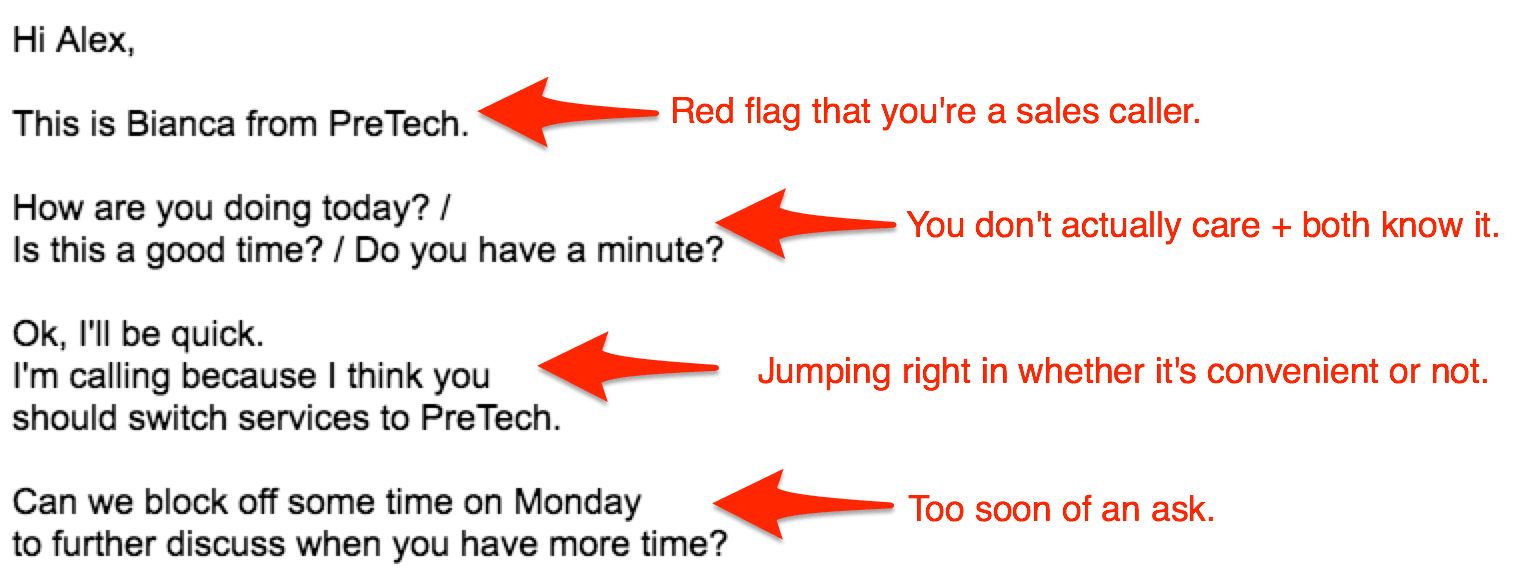It is not easy being a sales rep.
The most challenging part of the job is the daily barrage of sales calls to numerous prospects.
The best part? Closing the deal. It can be so self-rewarding.
A successful deal closure may not always be the case. For the most part, sales reps are met with annoyed, interruptive, and distracted clients on the other side of the phone.
This is why it is important to have a well-prepared sales script.
A sales script is more than a guide to steer the conversation, it also helps marketers know what to expect.
In this article, we are covering everything you need to know about mastering the sales call.
Table of Contents
Master Cold Calling: 6 Effective Tips
What makes a perfect sales pitch?
Here’s the secret – Any successful salesperson would tell you there is no perfect sales pitch and each sales call is different, you will have to improvise your way to the top.
That being said, here are curated tips that can help you create a robust sales script that will eventually help you reach the peak of the sales mountain.
Pro Tip #1. Start With a Bang
Hi, I’m Dwight Schrute calling from Dunder Mifflin. ❌
Hi, I’m Dwight and the weather today is fantastic isn’t it? ✔️
See what we did there?
Introducing your company with the first sentence might give the client the hint that you are a sales caller and prompt them to immediately hang up.
Instead, starting in a positive, conversational manner can help set the tone for the rest of the call.
The goal of a good introduction is to make the client feel comfortable enough to listen to what you have to say and to keep the conversation flowing.

Here is a breakdown of the introductory part of the sales call:
- Introduction: Keep the introduction warm and friendly while maintaining a professional tone. Kick-off in style to get the client hooked immediately. Be sure to introduce your company name secondarily.
- Transition/connecting statement: This is where you introduce the reason for your call. Have a clear connecting statement that ensures a smooth transition from your introduction while getting to the point quickly.
Here is an example:
“Before I dive into why I’m calling, I would like to congratulate you on your latest venture. I read it in XYZ magazine. Amazing news for our community. And so I wanted to discuss this latest proposal in connection to that” …
… And so on.
- Make room for the right questions: After presenting your main pitch it is important to make room for any questions our client might have. This can be an opportunity for you to present some questions that might strengthen the pitch. Although, it is advisable to avoid open-ended questions.
Pro Tip #2. Take It Slow
A common amateur mistake by most sales reps is rushing to the main pitch too fast.
The most important aspect of a sales call is the rapport you develop with the client and build from there. A little chit-chat and friendly banner can help establish this comfort bubble.
And most importantly it is not just enough to make noise during your introduction to hold the attention of the prospect for a moment, it is imperative to keep them hooked for the entirety of the conversation to ensure your message gets across.
Hold the attention and ensure the call holds a great value proposition to you as well as the client. Research into sales call analysis shows that a cold call is usually successful and results in a follow-up that lasts around 5 minutes.
Read also: How Sales Call Recording Helps Build an Effective Sales Team
Pro Tip #3. Keep the Sales Script Simple
Simplicity is key.
Your sales script should adhere to the key points and be crips in its delivery. It would be ideal to use more language that supports the value addition and problem-solving part of your product/service.
A sales pitch would resonate more with the prospect if you detail how the product would make their life better and how it is the solution to their problem rather than highlight its features blatantly.

Pro Tip #4. Use Emotions To Make a Point

Two emotions affect humans the most: Pain and pleasure. The best salesperson knows how to use these two emotions aptly to sell their business.
Concentrate on points that focus on how your product can ease the pain out of the client’s life while it adds value to their life. A product will seem more lucrative to the client if a connection is established between how the product could solve the issues for them.
Read also: Find The Best Time to Cold Call: Optimal Hours & Tips for Success
Pro Tip #5. Reiterate Your Plus Points
Cutthroat competition is imminent.
While it is important to market your product in the best light possible, avoid bad-mouthing your competitors to gain an edge at all costs. This will not only leave a bad impression but also project your brand as “desperate”.
Emphasis on what makes your product unique and versatile in a compelling but non-evasive manner. Make your position stronger by knowing what the company you are marketing to needs the most in advance and articulating your sales pitch according to this information.
There is also a possibility the client might question how your product is better than other competitors selling the same thing. This would be the perfect opportunity for you to highlight the differentiators that make the product or service stand apart.
Read also: What Is a Sales SPIFF? The Game-Changing Motivator for Sales Teams
Pro Tip #6. Leave With a Bang
Just as starting the sales call in style is important, ending the call on a positive but impressive note can guarantee a follow-up or even a sale.
Traditionally phrases like” looking forward to hearing from you soon” are the safer choice but are not impressive enough. Instead, leaving the client wanting more or expecting something the next time you call them is a great way to ensure the connection is not lost.
For instance, “Next time we connect, I would like to show you how our product XYZ worked for client ABC. Would next Tuesday be a good time?”.
This helps secure a follow-up while not sounding too persuasive and also gives something the prospect can look forward to.

Read also: 10 Elevator Pitch Examples to Convince Anyone in 30 Seconds
Preparing for a Sales Call
A good sales call involves preparation in all aspects well in advance, even weeks or months before the actual call. Here are some conducive practices to follow before you make the call:

#1. Set Clear Goals
Baby steps first.
To make sure you cover all the pain points during a sales call it is important to understand what your typical client profile looks like and work backward.
It is important to map out what your prospect’s goals are and what are YOUR expectations from the call to align your value proposition with the product or service you intend to promote with the call.

#2. Draft an Outline
The best sales calls are the ones well prepared following a well-researched and educational sales script.
The end goal of a successful sales call should not be to sell the product but rather to educate a potential client about the product or your business.
It is a good practice to inform clients beforehand what the call entails and what should be the expectations on both ends.
Adequate research needs to be done to understand the typical client profile fully. This will help tailor your sales pitch to each of the clients even if the basics remain the same.
A generic sales pitch will not reflect with the potential client as you want it to and will give you a resounding “no” as the most likely response.
Create a presentation that adheres specifically to the client’s needs that is more educative than convincing to increase the success rate.

#3. Expect the Unexpected
With a cold sales call, you need to be prepared for all types of responses.
Negative responses and objections are quite common and inevitable. You need to know how to steer the conversation positively when things go south.

Prepare all the possible objections you could face in relevance to your product and brand and outline how to tackle these smoothly.
Ensure you have all the information about the company you are marketing to as well as about your product and brand. The possibility of rejection is lower when you are prepared well in advance.

Wrapping Up: Key Takeaways
A cold sales call can leave even the expert marketers in a cold sweat.
While following a sales script that adheres to the points even covered in this article is important, it is equally important to improvise and let the conversation flow organically.
Another aspect is what to do after successful deal closure. Indicate what would be the next action items after a “yes” and other decisions that would require the involvement of a higher authority.
A good practice in general is to follow up the call with an email summarizing the points to refresh the client’s memory.
Although these points might seem simple, they are important to make sure your sales call is a cakewalk and you end up closing the deal.
Get set and start calling!
Let us know what other tricks helped you close a deal in the comment!




